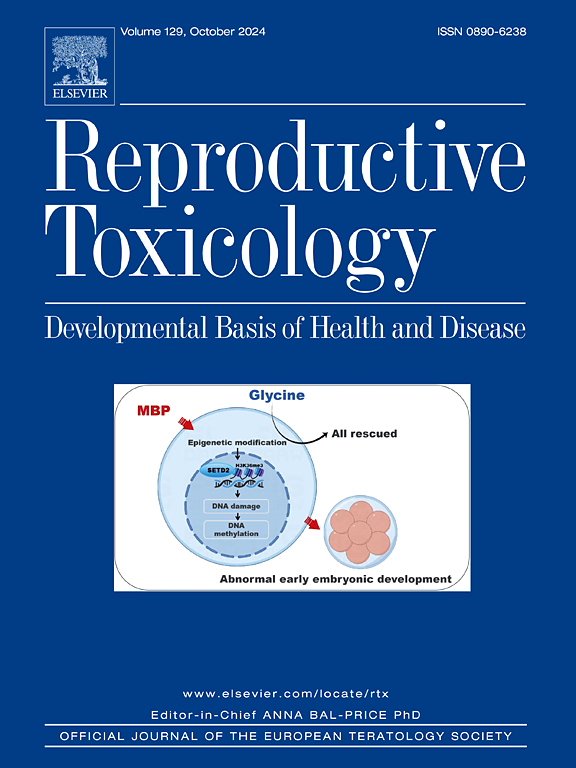Investigation of potential toxic effects of nano- and microplastics on human endometrial stromal cells
IF 3.3
4区 医学
Q2 REPRODUCTIVE BIOLOGY
引用次数: 0
Abstract
Nanoplastics (NPs) and microplastics (MPs) have become a global concern in recent years. Most current research on the impact of plastics on obstetrics has focused on their accumulation in specific tissues in animal models and the disease-causing potential of MPs. However, there is a relative lack of research on the cellular changes caused by the accumulation of MPs.
In this study, we aimed to establish a proper in vitro exposure protocol for polystyrene (PS)-NPs and MPs and to investigate possible cytotoxic effects of PS-NPs and MPs on human endometrial stromal cells (ESCs) using different plastic sizes and concentrations. The results showed that smaller plastics, specifically 100 nm PS-NPs and 1 μm PS-MPs, had a higher cellular uptake propensity than larger particles, such as 5 μm PS-MPs, with significant morphological changes and cell death observed at concentrations above 100 μg/mL a 24-h period. In addition, confocal microscopy and real-time imaging confirmed the accumulation of these particles in the nucleus and cytoplasm, with internalization rates correlating with particle size. Also, 100 nm PS-NPs reduced cell proliferation and induced apoptosis. In conclusion, this study demonstrates that exposure to 100 nm PS-NPs and 1 μm PS-MPs leads to dynamic accumulation in ESCs, resulting in cell death or decreased proliferation at specific concentrations, which highlights the potential cellular toxicity of NPs or MPs.
纳米和微塑料对人子宫内膜基质细胞潜在毒性作用的研究。
近年来,纳米塑料(NPs)和微塑料(MPs)已成为全球关注的热点。目前大多数关于塑料对产科影响的研究都集中在动物模型中塑料在特定组织中的积累以及MPs的致病潜力。然而,对MPs积累引起的细胞变化的研究相对缺乏。本研究旨在建立合适的聚苯乙烯(PS)-NPs和MPs的体外暴露方案,并研究不同塑料尺寸和浓度下PS-NPs和MPs对人子宫内膜基质细胞(ESCs)可能的细胞毒性作用。结果表明,100nm的PS-NPs和1 μm的PS-MPs比大颗粒的5 μm PS-MPs具有更高的细胞摄取倾向,在浓度超过100μg/mL的24小时内,细胞形态发生明显变化,细胞死亡。此外,共聚焦显微镜和实时成像证实了这些颗粒在细胞核和细胞质中的积累,其内化率与颗粒大小相关。100nm PS-NPs抑制细胞增殖,诱导细胞凋亡。综上所述,本研究表明,暴露于100nm的PS-NPs和1 μm的PS-MPs会导致ESCs的动态积累,在特定浓度下导致细胞死亡或增殖减少,这突出了NPs或MPs的潜在细胞毒性。
本文章由计算机程序翻译,如有差异,请以英文原文为准。
求助全文
约1分钟内获得全文
求助全文
来源期刊

Reproductive toxicology
生物-毒理学
CiteScore
6.50
自引率
3.00%
发文量
131
审稿时长
45 days
期刊介绍:
Drawing from a large number of disciplines, Reproductive Toxicology publishes timely, original research on the influence of chemical and physical agents on reproduction. Written by and for obstetricians, pediatricians, embryologists, teratologists, geneticists, toxicologists, andrologists, and others interested in detecting potential reproductive hazards, the journal is a forum for communication among researchers and practitioners. Articles focus on the application of in vitro, animal and clinical research to the practice of clinical medicine.
All aspects of reproduction are within the scope of Reproductive Toxicology, including the formation and maturation of male and female gametes, sexual function, the events surrounding the fusion of gametes and the development of the fertilized ovum, nourishment and transport of the conceptus within the genital tract, implantation, embryogenesis, intrauterine growth, placentation and placental function, parturition, lactation and neonatal survival. Adverse reproductive effects in males will be considered as significant as adverse effects occurring in females. To provide a balanced presentation of approaches, equal emphasis will be given to clinical and animal or in vitro work. Typical end points that will be studied by contributors include infertility, sexual dysfunction, spontaneous abortion, malformations, abnormal histogenesis, stillbirth, intrauterine growth retardation, prematurity, behavioral abnormalities, and perinatal mortality.
 求助内容:
求助内容: 应助结果提醒方式:
应助结果提醒方式:


